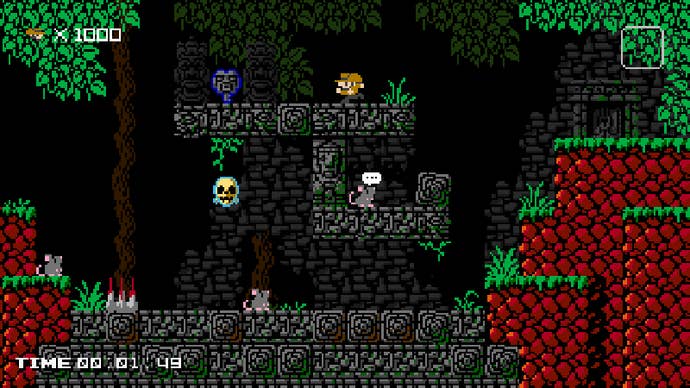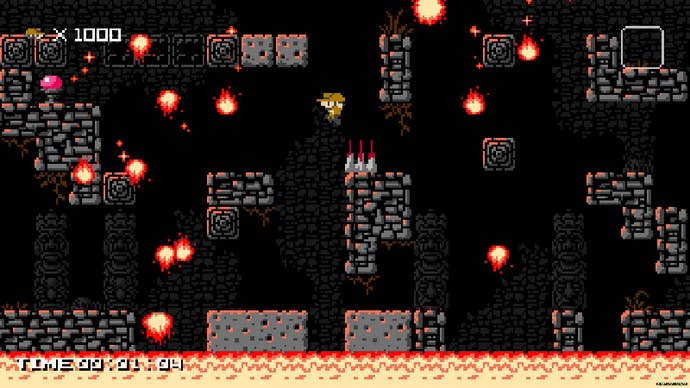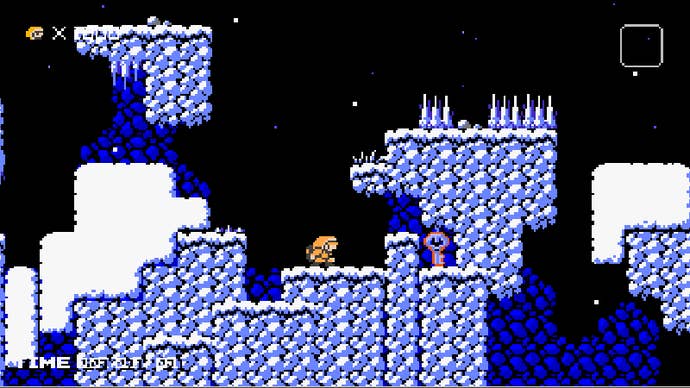1001 Spikes 3DS Review: A Murder Sim in Reverse
People complain that video games require too much violence on the player's behalf, but in this trap-happy test of platforming skill it's the game doing the killing.
This article first appeared on USgamer, a partner publication of VG247. Some content, such as this article, has been migrated to VG247 for posterity after USgamer's closure - but it has not been edited or further vetted by the VG247 team.
Jeremy Parish, Editor-in-Chief
I write about games a fair amount, and in the time that I've been skulking about in the games press I've come to regard certain ideas about game design as more or less sacrosanct — inviolable truths about what makes a good video game. Nicalis' 1001 Spikes breaks just about all of them.
And yet, 1001 Spikes manages to be a pretty excellent game despite its willful defiance of the commandments of game design. Thou shalt not spite the player? It's no coincidence that "1001 Spikes" is one letter removed from being "1001 Spites."
Thou shalt not beset the player with untelegraphed deaths? 1001 Spikes consists of dozens of levels of nothing but untelegraphed deaths.
Thou shalt provide checkpoints or other forms of clemency? At the end of 1001 Spikes' prologue you pass a checkpoint flag that breaks away and disappears uselessly.
Thou shalt not rely on rote memorization? 1001 Spikes consists almost entirely of memorization in such elaborate sequences that your short-term memory will start to lose track of a stage's first few hazards by the time you struggle your way to the last ones.
No, 1001 Spikes laughs in the face of modern game conventions and the mere concept of consideration. And it works.

It works because it commits wholly to breaking the rules. It embraces the concept of being devastatingly difficult by any means possible, of never giving the player a break, of unapologetically murdering you at any opportunity. It runs with it. You will die horribly in every stage, guaranteed; every time you think you've reached safe ground and can take a quick breather, a spike will spring from below to impale you, or a dart will speed across the screen, or the very earth itself will betray you by crumbling away to drop you into a pit.
So the game itself becomes about learning the ins and outs of these traps and hazards and charting a course through them. Nasty surprises aren't cheap or haphazard obstacles that come between you and some grand objective; no, nasty surprises are 1001 Spikes' raison d'être. They're the point. You're playing this game in order to overcome the titular spikes (although I'm pretty sure there are more than 1001 of them). The fact that there's a story and a canonical true boss for those who complete all the levels without skipping any — something I've yet to manage — is just gravy.
And in truth, 1001 Spikes doesn't really break all the rules of good game design. Underneath all that superficially cruelty, the mechanics and overall feel of the action are impeccable. It feels like a top-class NES game, all tightly defined sprites and tiles, with controls that do exactly what you want them to do; there are even two different buttons for jumping, one high and one low, to ensure that you always get it just right.
If you pay careful attention, you'll notice that no trap is truly untelegraphed. The tells for a rigged tile may be as minute as a couple of stray pixels, but the signs are there for the observant. Maybe it's the way the gargoyle mounted on the wall has its tiny mouth slightly ajar to denote it doubles as a dart launcher. Maybe it's the slightly different pattern on the floor tile to signify its fragility. You may not spot them in the heat of the moment, but the clues are there are if you care to look.

It's not as though 1001 Spikes is unprecedented in its design philosophy, either. It slots neatly into the kill-frenzied platformer genre as defined by the likes of Super Meat Boy, VVVVVV, Splosion Man, Battle Kid and the Fortress of Peril, and others of their ilk. Yet it feels decidedly different than its predecessors. VVVVVV, for example, is more about tiny, bite-sized challenges, while something like N+ is more about taking in a vast playing field a bit at a time. The levels in 1001 Spikes are more like brief stages from 8-bit classics like Castlevania or Ninja Gaiden, but far denser, more challenging, and more complex. It embodies the "everything kills you" mentality of early NES games with the precision and refinement of that system's latter-day classics.
Still, I love that 1001 Spikes is so openly hostile. It even saves the game every time you die so you can't practice a stage before giving it a proper runthrough — every single failure counts against your stock of 1001 lives. It's a sign of supreme confidence in the game's design, and in the player's commitment to sticking it out and overcoming some of the most hilariously deadly stage designs ever made. Sometimes to get ahead, you have to break the rules.
Bob Mackey, Senior Writer
If you want to enjoy 1001 Spikes, you'll have to come to terms with its distinct sense of unfairness, because that's kind of the point. All of the lessons learned come through dying, and I'd say more than half of those deaths are "gotcha" moments meant to be filed away in your brain for the next attempt. Really, 1001 Spikes is half hardcore platformer, and half short-term memory exercise, as making progress through its meticulously designed levels involves figuring out and remembering the precise movements required to navigate around every deathtrap, and executing these actions perfectly. It makes for a feeling of complete satisfaction when you reach the end and hear that charming victory fanfare, but the process up to that point involves a lot of laughing at yourself for immediately wandering into an obvious set of spikes seconds out of the gate.
1001 Spikes definitely isn't designed for marathon sessions—it's one of those experiences where you'll repeatedly bash your head against a challenge, walk away for a few hours, and return to beat it in your first try. Thankfully, the levels are short enough to hold up to repeated playthroughs, much like Super Meat Boy. Above all, I'm just impressed by how downright evil 1001 Spikes can be, as it does an amazing job of predicting the player's most likely action, and doles out harsh punishment for moving without thinking. Just as a level reaches its bitter end, 1001 Spikes exploits impatience by throwing up some entirely avoidable but still unexpected traps designed to rob you of victory just as it's within sight. And those safe zones that seem designed for you to catch your breath aren't always entirely safe.

Based on its looks, it might be easy to confuse 1001 Spikes with La Mulana and Spelunky, two other Indy indies that emphasize extreme difficulty, but 1001's focus on meticulousness and memorization makes for a much different experience. If you don't mind being screwed with, it will likely get more laughs out of you than most games designed explicitly with humor in mind. Those of you with a quick temper might want to consider tethering the Vita to your wrist, unless you're intent on single-handedly boosting its sales numbers via multiple replacements.
VisualsPrimitive and 8-bit for a reason — not just to call back to the games that inspired it, but also to help ensure the telltale details of each trap are subtle and demand careful attention.
SoundGreat classic chiptunes and spot-on retro sounds effects. Though you'll quickly grow to hate the death jingle.
InterfaceSimple and smart. The presence of two different jump buttons seems strange until you get to areas where you want to be sure you don't accidentally jump too high.
Lasting AppealYou can skip through the stages to the end, but if you want to complete the game properly, you'd better prepare to spend a ton of time mastering each and every stage. Also, multiplayer!
ConclusionMaybe retro-style indie games are getting a bit long in the tooth, but 1001 Spikes is an example of the format done right: It harnesses that old-school look for a reason and focuses in on a single design concept with obsessive clarity. Developer 8bit Fanatics really gets what made the best classic games great, and manages to make a hateful, hurtful game into addictive fun. And the multiplayer mode (on systems that support it) is surprisingly great, a mix of Contra and The Outfoxies. Maybe it's not a game for everyone, but 1001 Spikes knows what it's about... and does a bang-up job of achieving it.








